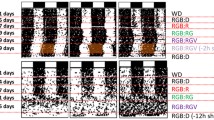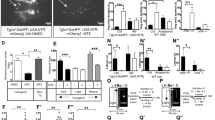Abstract
In mammals, early light experience during a critical period within the first 3 weeks of postnatal development has long-lasting effects on circadian locomotor activity behaviour and neuropeptide expression in the suprachiasmatic nucleus (SCN) of the hypothalamus, site of the principal pacemaker. Dopamine is thought to be involved in the modulation of photic input within the SCN and in tadpoles, the expression of tyrosine hydroxylase (TH), a rate-limiting enzyme in the synthesis of dopamine, in the SCN is altered by previous light history. We thus hypothesised that dopaminergic neurons may be important for the development of the adapted responses to light that we have previously observed. To test this, we raised mice in either constant darkness, 12:12 h light–dark cycles or constant light during the first 3 weeks after birth, and later examined the expression of TH and FOS in the hypothalamus of these mice as adults, both in the dark and after exposure to a light pulse. We found that early light experience affects TH and FOS expression, both baseline levels and in response to a light pulse, in brain areas which are directly connected to the SCN, and are associated with the circadian control of neuroendocrine function. Therefore, our results suggest that the long-lasting alterations induced by early light environment on several hypothalamic nuclei may be relayed through the SCN, and that TH-expressing cells may play a role in conveying/establishing these alterations. These data suggest a role of early light experience in the regulation of future hormonal homeostasis and circadian behaviour.






Similar content being viewed by others
Abbreviations
- ADP:
-
Anterodorsal preoptic nucleus
- ARC:
-
Arcuate nucleus
- AVP:
-
Arginine vasopressin
- CT:
-
Circadian time
- DD:
-
Constant dark
- DMH:
-
Dorsomedial hypothalamic nucleus
- FOS+:
-
cFOS-positive cells
- LD:
-
Light–dark
- LL:
-
Constant light
- PE:
-
Periventricular hypothalamic nucleus
- PVN:
-
Paraventricular hypothalamic nucleus
- SCN:
-
Suprachiasmatic nucleus
- SPZ:
-
Subparaventricular zone of the hypothalamus
- TH:
-
Tyrosine hydroxylase
- TH+:
-
TH-positive cells
- TH/FOS+:
-
TH- and cFOS-positive cells
- VIP:
-
Vasointestinal polypeptide
- ZI:
-
Zona incerta
References
Abrahamson EE, Moore RY (2001) Suprachiasmatic nucleus in the mouse: retinal innervation, intrinsic organization and efferent projections. Brain Res 916(1–2):172–191
Antle MC, Silver R (2005) Orchestrating time: arrangements of the brain circadian clock. Trends Neurosci 28(3):145–151
Arancibia S, Rage F, Grauges P, Gomez F, Tapia-Arancibia L, Armario A (2000) Rapid modifications of somatostatin neuron activity in the periventricular nucleus after acute stress. Exp Brain Res 134(2):261–267
Baffi JS, Palkovits M (2000) Fine topography of brain areas activated by cold stress. A fos immunohistochemical study in rats. Neuroendocrinology 72(2):102–113
Battaglia AA, Beltramo M, Thibault J, Krieger M, Calas A (1995) A confocal approach to the morphofunctional characterization of the transient tyrosine hydroxylase system in the rat suprachiasmatic nucleus. Brain Res 696(1–2):7–14
Beltramo M, Calas A, Chernigovskaya E, Borisova N, Polenova O, Tillet Y, Thibault J, Ugrumov M (1994) Postnatal development of the suprachiasmatic nucleus in the rat. Morpho-functional characteristics and time course of tyrosine hydroxylase immunopositive fibers. Neuroscience 63(2):603–610
Blevins JE, Baskin DG (2010) Hypothalamic-brainstem circuits controlling eating. Forum Nutr 63:133–140
Cambras T, Canal MM, Torres A, Vilaplana J, Diez-Noguera A (1997) Manifestation of circadian rhythm under constant light depends on lighting conditions during lactation. Am J Physiol 272((4 Pt 2)):R1039–R1046
Canal MM, Mohammed NM, Rodriguez JJ (2009) Early programming of astrocyte organization in the mouse suprachiasmatic nuclei by light. Chronobiol Int 26(8):1545–1558
Canal-Corretger MM, Vilaplana J, Cambras T, Diez-Noguera A (2001a) Effect of light on the development of the circadian rhythm of motor activity in the mouse. Chronobiol Int 18(4):683–696
Canal-Corretger MM, Vilaplana J, Cambras T, Diez-Noguera A (2001b) Functioning of the rat circadian system is modified by light applied in critical postnatal days. Am J Physiol Regul Integr Comp Physiol 280(4):R1023–R1030
Canal-Corretger MM, Cambras T, Vilaplana J, Diez-Noguera A (2003) The manifestation of the motor activity circadian rhythm of blinded rats depends on the lighting conditions during lactation. Chronobiol Int 20(3):441–450
Ceccatelli S, Cintra A, Hokfelt T, Fuxe K, Wikstrom AC, Gustafsson JA (1989) Coexistence of glucocorticoid receptor-like immunoreactivity with neuropeptides in the hypothalamic paraventricular nucleus. Exp Brain Res 78(1):33–42
Colwell CS, Foster RG (1992) Photic regulation of Fos-like immunoreactivity in the suprachiasmatic nucleus of the mouse. J Comp Neurol 324(2):135–142
Cullinan WE, Herman JP, Battaglia DF, Akil H, Watson SJ (1995) Pattern and time course of immediate early gene expression in rat brain following acute stress. Neuroscience 64(2):477–505
Duffield GE, McNulty S, Ebling FJ (1999) Anatomical and functional characterisation of a dopaminergic system in the suprachiasmatic nucleus of the neonatal Siberian hamster. J Comp Neurol 408(1):73–96
Dulcis D, Spitzer NC (2008) Illumination controls differentiation of dopamine neurons regulating behaviour. Nature 456(7219):195–201
Ebling FJ (1996) The role of glutamate in the photic regulation of the suprachiasmatic nucleus. Prog Neurobiol 50(2–3):109–132
Hannibal J, Fahrenkrug J (2004) Target areas innervated by PACAP-immunoreactive retinal ganglion cells. Cell Tissue Res 316(1):99–113
Hattar S, Liao HW, Takao M, Berson DM, Yau KW (2002) Melanopsin-containing retinal ganglion cells: architecture, projections, and intrinsic photosensitivity. Science 295(5557):1065–1070
Horvath TL (1997) Suprachiasmatic efferents avoid phenestrated capillaries but innervate neuroendocrine cells, including those producing dopamine. Endocrinology 138(3):1312–1320
Jaeger CB, Albert VR, Joh TH, Reis DJ (1983) Aromatic L-amino acid decarboxylase in the rat brain: coexistence with vasopressin in small neurons of the suprachiasmatic nucleus. Brain Res 276(2):362–366
Karasawa N, Arai R, Isomura G, Yamada K, Sakai K, Sakai M, Nagatsu T, Nagatsu I (1994) Phenotypic changes of AADC-only immunopositive premammillary neurons in the brain of laboratory shrew Suncus murinus by systemic administration of monoamine precursors. Neurosci Lett 179(1–2):65–70
Karasawa N, Hayashi M, Yamada K, Nagatsu I, Iwasa M, Takeuchi T, Uematsu M, Watanabe K, Onozuka M (2007) Tyrosine hydroxylase (TH)- and aromatic-L-amino acid decarboxylase (AADC)-immunoreactive neurons of the common marmoset (Callithrix jacchus) brain: an immunohistochemical analysis. Acta Histochem Cytochem 40(3):83–92
Kiss A, Mravec B, Palkovits M, Kvetnansky R (2008) Stress-induced changes in tyrosine hydroxylase gene expression in rat hypothalamic paraventricular, periventricular, and dorsomedial nuclei. Ann N Y Acad Sci 1148:74–85
Kiyohara T, Miyata S, Nakamura T, Shido O, Nakashima T, Shibata M (1995) Differences in Fos expression in the rat brains between cold and warm ambient exposures. Brain Res Bull 38(2):193–201
Laemle LK (1988) Vasoactive intestinal polypeptide (VIP)-like immunoreactivity in the suprachiasmatic nucleus of the perinatal rat. Brain Res 469(1–2):308–312
Laemle LK, Repke KB, Hawkes R, Rice FL (1991) Synaptogenesis in the rat suprachiasmatic nucleus: a light microscopic immunocytochemical survey. Brain Res 544(1):108–117
Lookingland KJ, Moore KE (2005) Functional neuroanatomy of hypothalamic dopaminergic neuroendocrine systems. In: Dunnett SB, Bentivoglio M, Björklund A, Hökfelt T (eds) Handbook of chemical neuroanatomy, vol 21. Elsevier, Amsterdam, pp 435–523
Mahoney MM, Ramanathan C, Smale L (2007) Tyrosine hydroxylase positive neurons and their contacts with vasoactive intestinal polypeptide-containing fibers in the hypothalamus of the diurnal murid rodent, Arvicanthis niloticus. J Chem Neuroanat 33(3):131–139
Mitrofanis J (2005) Some certainty for the “zone of uncertainty”? Exploring the function of the zona incerta. Neuroscience 130(1):1–15
Miyata S, Ishiyama M, Shibata M, Nakashima T, Kiyohara T (1998) Infant cold exposure changes Fos expression to acute cold stimulation in adult hypothalamic brain regions. Neurosci Res 31(3):219–225
Moore RY (1982) The suprachiasmatic nucleus and the organization of a circadian system. Trends Neurosci 5:404–407
Moore RY (1991) Development of the suprachiasmatic nucleus. In: Klein DC, Moore RY, Reppert SM (eds) Suprachiasmatic nucleus: The mind’s clock. Oxford University Press, Oxford, pp 391–404
Morin LP (1994) The circadian visual system. Brain Res Brain Res Rev 19(1):102–127
Novak CM, Nunez AA (1998) Tyrosine hydroxylase- and/or aromatic L-amino acid decarboxylase-containing cells in the suprachiasmatic nucleus of the Syrian hamster (Mesocricetus auratus). J Chem Neuroanat 14(2):87–94
Paxinos G, Franklin K (2004) The mouse brain in stereotaxic coordinates. Academic Press, New York
Ruggiero DA, Baker H, Joh TH, Reis DJ (1984) Distribution of catecholamine neurons in the hypothalamus and preoptic region of mouse. J Comp Neurol 223(4):556–582
Saper CB, Lu J, Chou TC, Gooley J (2005) The hypothalamic integrator for circadian rhythms. Trends Neurosci 28(3):152–157
Smith L, Canal MM (2009) Expression of circadian neuropeptides in the hypothalamus of adult mice is affected by postnatal light experience. J Neuroendocrinol 21(11):946–953
Strother WN, Norman AB, Lehman MN (1998) D1-dopamine receptor binding and tyrosine hydroxylase-immunoreactivity in the fetal and neonatal hamster suprachiasmatic nucleus. Brain Res Dev Brain Res 106(1–2):137–144
Tillet Y, Caldani M, Tramu G (1989) Immunohistochemical characterization of the sheep suprachiasmatic nucleus. J Chem Neuroanat 2(4):215–226
Tillet Y, Thibault J, Krieger M (1994) Aromatic L-amino acid decarboxylase immunohistochemistry in the suprachiasmatic nucleus of the sheep. Comparison with tyrosine hydroxylase immunohistochemistry. Brain Res 648(2):319–323
Ugrumov MV, Popov AP, Vladimirov SV, Kasmambetova S, Thibault J (1994) Development of the suprachiasmatic nucleus in rats during ontogenesis: tyrosine hydroxylase immunopositive cell bodies and fibers. Neuroscience 58(1):151–160
van den Pol AN, Tsujimoto KL (1985) Neurotransmitters of the hypothalamic suprachiasmatic nucleus: immunocytochemical analysis of 25 neuronal antigens. Neuroscience 15(4):1049–1086
Veening JG, Bouwknecht JA, Joosten HJ, Dederen PJ, Zethof TJ, Groenink L, van der Gugten J, Olivier B (2004) Stress-induced hyperthermia in the mouse: c-fos expression, corticosterone and temperature changes. Prog Neuropsychopharmacol Biol Psychiatry 28(4):699–707
Vincent SR (1988) Distributions of tyrosine hydroxylase-, dopamine-beta-hydroxylase-, and phenylethanolamine-N-methyltransferase-immunoreactive neurons in the brain of the hamster (Mesocricetus auratus). J Comp Neurol 268(4):584–599
Viswanathan N, Weaver DR, Reppert SM, Davis FC (1994) Entrainment of the fetal hamster circadian pacemaker by prenatal injections of the dopamine agonist SKF 38393. J Neurosci 14(9):5393–5398
Vosko AM, Schroeder A, Loh DH, Colwell CS (2007) Vasoactive intestinal peptide and the mammalian circadian system. Gen Comp Endocrinol 152(2–3):165–175
Watts (1991) The efferent projections of the suprachiasmatic nucleus: anatomical insights into the control of circadian rhythms. In: Klein DC, Moore RY, Reppert SM (eds) Suprachiasmatic nucleus: the mind’s clock. Oxford University Press, Oxford, pp 77–106
Watts AG, Swanson LW, Sanchez-Watts G (1987) Efferent projections of the suprachiasmatic nucleus: I. Studies using anterograde transport of Phaseolus vulgaris leucoagglutinin in the rat. J Comp Neurol 258(2):204–229
Weaver DR, Roca AL, Reppert SM (1995) c-fos and jun-B mRNAs are transiently expressed in fetal rodent suprachiasmatic nucleus following dopaminergic stimulation. Brain Res Dev Brain Res 85(2):293–297
Acknowledgments
This work was supported by funding from the Research Councils UK, and the Biotechnology and Biological Sciences Research Council (BBSRC) to MMC. EB is a recipient of a Medical Research Council (MRC) doctoral training award.
Author information
Authors and Affiliations
Corresponding author
Rights and permissions
About this article
Cite this article
Brooks, E., Waters, E., Farrington, L. et al. Differential hypothalamic tyrosine hydroxylase distribution and activation by light in adult mice reared under different light conditions during the suckling period. Brain Struct Funct 216, 357–370 (2011). https://doi.org/10.1007/s00429-011-0318-9
Received:
Accepted:
Published:
Issue Date:
DOI: https://doi.org/10.1007/s00429-011-0318-9




